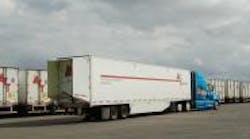“Fleets now understand that they are throwing away millions of dollars annually by not improving the aerodynamics at the rear of their trailers.” –Andrew Smith, founder and CEO of ATDynamics
I got a note last night that Mesilla Valley Transportation – a New Mexico-based fleet long known for its willingness to test and adopt new trucking technology – is going to refit its entire fleet of 3,500 long-haul 53-foot trailers with the TrailerTail rear aerodynamic device built by ATDynamics, Inc.
This is no cheap upgrade, mind you: it’s a multi-million dollar, 12-month long retrofit and is probably one of the largest such after-market refurbishments ever.
Mesilla believes its massive trailer retrofit is going to cut its diesel fuel consumption by over one million gallons annually; a cost savings of over $3 million at current diesel prices. And, by extension, those fuel savings will cut carbon dioxide (CO2) emissions the fleet generates by over 11,000 tons annually – the equivalent to taking over 2,000 cars off American roads.
Now, of course, Mesilla operates in California an awful lot – and the Golden State has some new rules mandating greater fuel efficiency from 53 foot trailers, courtesy of the California Air Resources Board’s (CARB) new heavy-duty tractor-trailer greenhouse gas (GHG) regulation that went into effect Jan. 1 this year. So, whether fleets are based in California or not, if they operate 53-foot trailers within the Golden State’s borders, they must comply with this new mandate.
Yet fleets are also discovering that the aerodynamic upgrades they’re making to their trailers are saving them a bundle – so much so that some believe they’d be making these changes irrespective government “must-do” rules.
For example, Tacoma, WA-based Interstate Distributor Co. says the fuel efficiency gains it’s achieving via new aerodynamic side fairings on its trailers should more than outweigh the cost of installation within a relatively short time frame.
In a conference call back in August, Lee Owens, Interstate’s senior vp of maintenance and facilities, said the company tested trailer side skirts for the past few years, achieving 3% to 5% improvements in fuel economy, depending upon the route and the speed its units travelled.
“And that 3% to 5% range is very conservative,” Owens stressed. “Basically, with that kind of efficiency gain, we’d have installed side fairings on our trailers whether they were mandated or not. The benefits are too big to ignore.”
Interstate operates a fleet of more than 2,000 tractors and 6,800 trailers and is currently installing Aeroflex side skirts from Seattle-based Freight Wing on 2,058 of its trailers. The carrier is getting the cost of installation partially offset via a $175,000 grant from the Pacific Northwest Pollution Prevention Resource Center (PPRC).
Mesilla’s reasons for adopting trailer tails mirror Interstate’s thinking as well. “In our industry, being more efficient means being more competitive,” said Royal Jones, the company’s CEO.
“This trailer technology is cost-effective, reliable and available today. The fuel savings we get from TrailerTails provide a 50% to 100% return on capital investment in one year,” he said.
“Fleets now understand that they are throwing away millions of dollars annually by not improving the aerodynamics at the rear of their trailers,” Andrew Smith, founder and CEO of ATDynamics, told me via email from Germany.
“The sole reason Mesilla Valley is investing in TrailerTail technology is to save fuel – a lot of fuel. Trailers with our TrailerTails or side skirts would comply with CARB regulations, and Mesilla is doing both. But they are not phasing in this equipment as what’s allowed per the regulations; they are implementing a fleet-wide retrofit program to get the fuel savings as quickly as possible,” he told me.
“No trucking company is going to win in the marketplace by simply complying with regulations,” Smith stressed.
Smith added that ATDynamics is working with Mesilla to train an on-the-ground team in El Paso, TX, to retrofit all of the fleet’s 3,500 trailers over the next 12 months, with the first 200 already on the road as of Augsut. It takes about two hours to retrofit a trailer with a full ATDynamics TrailerTail and skirt package, but the nice thing is the fuel savings start as soon as the trailer pulls out of the shop and back onto the highway.
Smith noted that the TrailerTail alone is proven to increase tractor-trailer fuel efficiency by 6.58% at 65 mph, based on third-party SAE J1321 testing. It achieves those figures by reducing low-pressure suction drag at the rear of a Class 8 tractor-trailer. Used in tandem with ATDynamics’ Transtex trailer skirting and other trailer aerodynamics enhancements, tractor-trailers can achieve fuel savings of 12%, he said.
“In addition to significant fuel savings, TrailerTails also help reduce spray at the rear of trailers in wet weather and encouraging safer driving distance between the rigid steel frame of trailers and passenger vehicles,” Smith added.
But it’s the potential fuel savings that really matter to truckers. “Rear drag aerodynamics technology will save America’s long haul freight sector over $3 billion a year in fuel costs,” he said. “A trailer without a tail is a trailer which is wasting fuel.”



